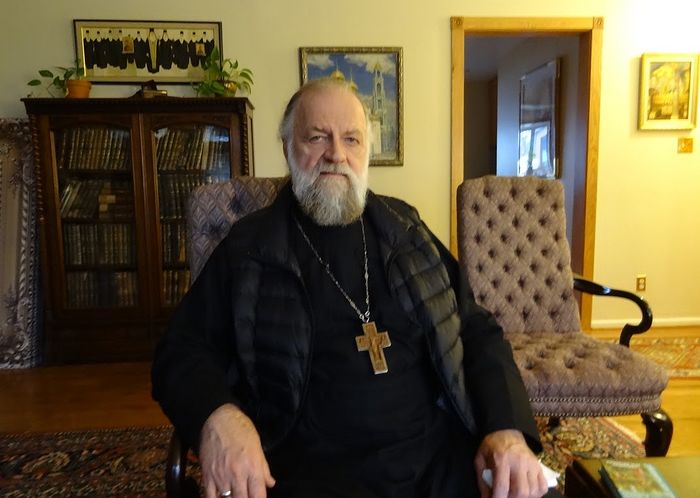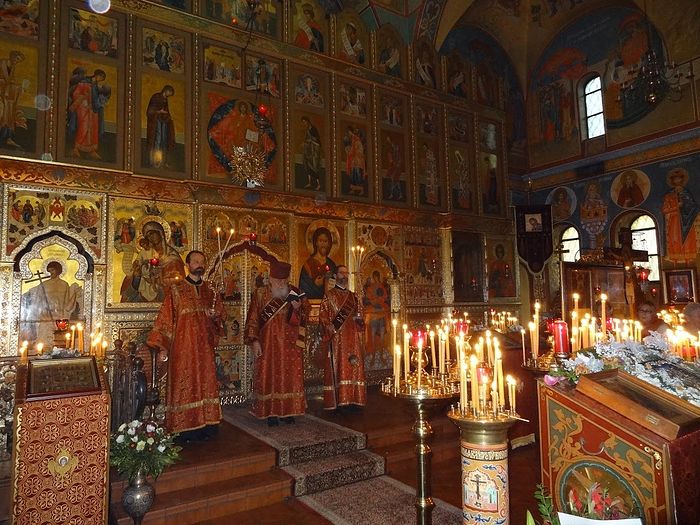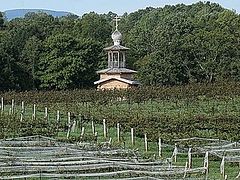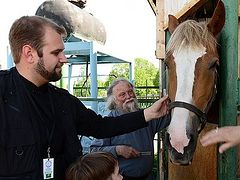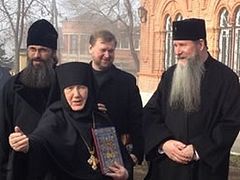Many people in America and Russia know Archpriest Victor Potapov. Fr. Victor’s family found themselves in the United States after the Second World War, arriving from the German Manchenhof refugee camp, where Fr. Victor was born in 1948. He worked for thirty years on the radio station, “Voice of America”, conducting religious programs for Russian Orthodox people. He has been serving for thirty-eight years as head priest of the St. John the Baptist Cathedral in Washington, D.C.
—Fr. Victor, you are Russian, but you grew up in America…
—I grew up in America in the 1950s. The Cold War was on. Several times a week we were supposed hide under our desks at school to prepare ourselves for a Soviet attack. We even knew that at the end of the street there was an anti-missile station. We boys used to go to the fence and peek in—there was a small military station there, and that intrigued us.
It wasn’t very pleasant to be Russian in those years when everyone was continually talking about the “Soviet threat”. The task of our Russian emigration was to convince Americans that there is a big difference between Russia and the Soviet Union. Russia is an Orthodox country, there was a revolution there, and godless people who persecute Christians and Russians came into power.
In my childhood awareness it worked like this: my parents made me speak Russian, go to Saturday Russian classes at our church, and I didn’t want to. My parents were not very church-going people; they only went now and then, and on the feasts. The religious person in my family was my grandmother.
When I was thirteen or fourteen, my mother once asked me to take my grandmother to church for the Vigil service. We lived in Cleveland, Ohio. Our church was located in a very bad, high-crime neighborhood. At that time, the Russian community in Cleveland could not afford anything else. Later they moved to another area and built a new church. Grandmother wanted very badly to go to the Vigil but I didn’t want to go, and there was a scandal. Nevertheless I loved my grandmother and so I went.
There was hardly anyone in the church, only the priest, Fr. Michael Smirnov, who would later play an important role in my life. So I stood there awkwardly, no young people near, I couldn’t understand the services, in fact I didn’t even speak very good Russian at the time… But then during the services something in my soul changed. And though understanding very little with my ears, I suddenly understood with my soul that these divine services have very deep meaning. It was just one incident, but it turned everything upside down in me.
I remember: I returned home, and checked out some books from the Holy Trinity Monastery in Jordanville. God’s church and Church services by Priest Antonov, The Law of God by Archpriest Seraphim (Slobodskoy), and others. I began reading—in Russian, although I read poorly in Russian. I started studying all this, and going to church. I would visit Fr. Michael at home, and he taught me how to read Church Slavonic.
During summer vacation I went to camp at the Holy Trinity Monastery in Jordanville, where there was a program for boys. We lived there for two or three weeks together with the monks, attended services, and did obediences. We were like young novices. One seminarian from Australia, from the Chinese emigration,1 Vladimir Evsiukov, a future archpriest, was my instructor. All of this led me to the decision to serve in the Church. One service, at which I didn’t even understand the words, completely changed my life. Can you imagine?
In 1970 I studied at seminary as a second year student. My mother and I wanted to travel to the USSR, to our relatives in Krasnodar. I had never been to the USSR before in my life. But there was some huge world communism convention going on in Moscow and they refused us visas. They said that there were no rooms at the hotels…
It was summer; I had to do something with my time, and it was already too late to get a job. So I decided to use that time to go to Mt. Athos, and then join up with a group of pilgrims from New York in the Holy Land. This group was headed by the future Metropolitan Laurus. Then he was Bishop Laurus, rector of the Holy Trinity Seminary. I went to Mt. Athos, visited the Russian St. Panteleimon Monastery, the St. Elias Skete, and other monasteries. I met there Archimandrite Abel (Makedonov), who was the abbot of the St. John the Theologian Monastery near Ryazan. A remarkable pastor! I was a seminarian in the Russian Church Abroad. I remember, Fr. Abel told me he was surprised that I related to him with such great respect. There was enmity at the time [between the Russian Church Abroad and the Moscow Patriarchate], unfortunately… But they received me with the utmost hospitality! There were also monks from the Pochaev Lavra and the Pskov Caves Monastery. They invited me to come and live for a year on Mt. Athos, to learn the rule… And I was taken with such a yearning for monasticism!
In this state of mind, after Mt. Athos I went to Jerusalem in order to join Vladyka Laurus’s group. We traveled to the holy places. In the group there was one pilgrimess from New York, an elderly woman, who took a great liking to me and we became friends. She introduced me to a girl.
I met my future matushka [priest’s wife] at the Lord’s Sepulcher. This was one of the greatest acquisitions of my life. So, I became an archpriest—you can’t ague with God’s Providence. Matushka and I have been together for forty-five years. I simply can’t imagine my pastoral activity without her, because a significant portion of the charitable work done at our parish is bound up with my matushka. This all came from the school of Archbishop John of Shanghai, near which my matushka grew up.
—Fr. Victor, as an American, you never forgot about Russia…
—You know, we feel for Russia. I grew up in America and am an American citizen. I don’t have a Russian passport, although I think about it at times. Much has changed in America for the worse… We always follow what is going on in Russia and feel for the country—how everyone is against it…
I recall the prophecies of the elders of the nineteenth century about how Russia will resurrect, that it will be spiritually very strong, the last stronghold of Orthodoxy in the world—and I can see that this is happening! And I rejoice that we are even in some small measure taking part in it! There was a time when I conducted religious radio programs for Russia, when there were no native ones. I was just a boy off the street when they handed me a microphone and began that work. I became—to make a great exaggeration—a radio journalist; although I had no journalistic education whatsoever. And so I started broadcasting. Thank God, there were people in the American government who understood that religious broadcasts at that time could bring even more benefit to the Soviet Union than political ones.
For thirty years I had the honor of being before an open microphone, giving catechetical talks, sermons, interviews with interesting people, explanations of Church feasts and services. The services in our church were even translated—evening services and Liturgy… Now in Russia there are “Spas”, “Radonezh”, and “Soyuz” [media channels]. I used to say that the time would come when my programs would no longer be needed. And that time, thank God, has come—even during my lifetime. This is a great mercy of God.
Now these broadcasts are not being done, but we do have a full-blooded parish life…
—How does your parish live?
—We have five priests and four deacons. Our parish is mainly Russian, sixty-seventy percent. There are Americans, Serbs, Romanians, even Chinese… They came to know Orthodoxy, and love the Russian spiritual traditions. Out of the thirty-eight years that I have served here, for twenty years we have served parallel Slavonic and English services. After services everyone goes to trapeza. We have a breakfast made and organized by the parishioners. There are both Russian and English language Sunday schools. There are also common services. Our official language is Russian. We publish a monthly magazine in Russian, which is translated into English for those who do not know Russian. We try not to forget anyone in our pastoral care.
We have two church choirs that practice regularly and take it seriously. There is a talented group called “Matryeshki”—boys and girls who get together every Friday and rehearse Russian folk dances, and give concerts. But perhaps the main thing that this does is to give us an excuse to get together. They live like one big family, get acquainted and make friends.
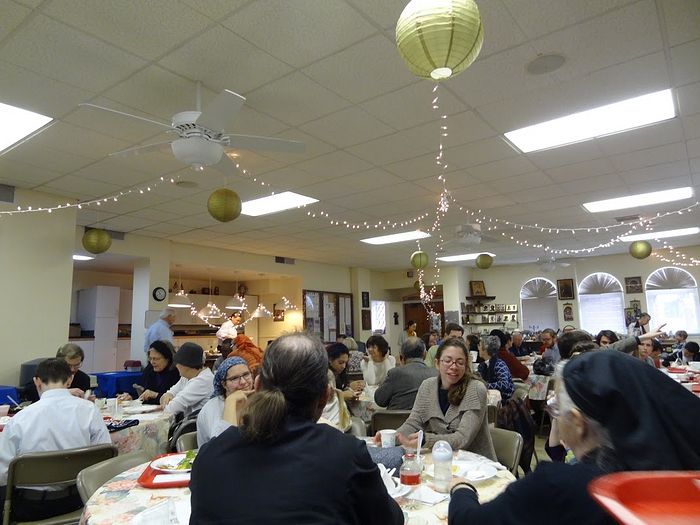 Common trapeza after the Liturgy.
Common trapeza after the Liturgy.
We have a scout movement. Our scout group meets here at the parish every other Saturday. This year we marked the fiftieth anniversary of our group, which is named after the ancient Russian city of Putivl. They also live like one big family, with common interests. Every summer they go camping with tents and build a chapel with their own hands. One of us comes to serve Divine Liturgy and evening services, and have talks with the kids. We priests also live in tents while we’re there. We take as much care as we can to uphold our scout tradition—it was alive even in the emigration. Thank God, after the fall of the Soviet Union our scout organization was able to pass on and return that tradition to Russia, and now scout movements are growing in Russia.
We have around 500 families in our parish. Membership in the parish is determined by membership fees paid—thirty-five dollars per month. Students and retired persons pay fifteen dollars. This is a small membership fee, but it gives us the possibility to see who is really a member of the parish. They have the right to be present and vote at the annual meetings, choose members of the church council, make suggestions, and express their concerns. The church rector is the president.
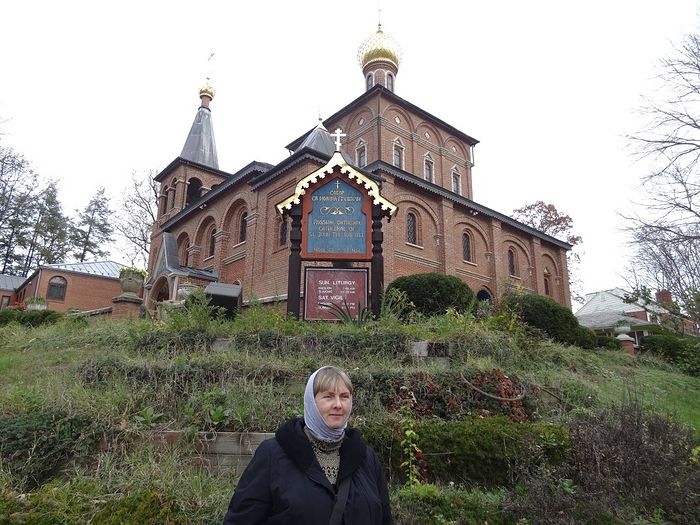 St. John the Baptist Cathedral
St. John the Baptist Cathedral
Now we have fifteen members of the parish council. We gather once a month to discuss current affairs in the life of the parish, along with maintenance and administrative matters.
We have very active charity work.
In November a member of our Haitian mission died unexpectedly—the remarkable priest Fr. Gregory Legute. He was the heart and soul of our mission. He was fifty-three years old. On Haiti there are five parishes of the Russian Church Abroad and 7000 faithful. These are all Haitians. They are very poor, can barely feed themselves, and are entirely dependent upon charity received from parishes of the Russian Church Abroad. We conducted a plate offering to support his matushka, because Fr. Gregory and his matushka supported a school where 130 Orthodox children studied. We were able to collect a fairly sizable amount. Other parishes also collected.
A significant sum was collected by our parishioners for a family in St. Petersburg. They have a wonderful daughter named Nadezhda who at age six was diagnosed with brain cancer. The tumor was removed in Russia but she went blind—during the operation an optic nerve was damaged. She was brought here to America, and she is now nine years old. Her father cannot work because he has no emigration papers, and the parents are making every sacrifice to help their daughter.
We have also collected a significant sum for the “Kindness” (Dobrota) fund in Donetsk, which helps children who were wounded during the civil war.
We work very closely with the Russian embassy; they let us celebrate Cheesefare week in their quarters, in the great Gold Room. The entire net profit from this evening—usually about 40,000 dollars—goes to our charitable fund, and we delegate these funds as we see fit throughout the year.
In January during the fast-free period we have our annual Tatiana ball organized by our youth. The entire net profits from the ball also go to the charitable fund of the St. John the Baptist Cathedral in order to help needy youth.
Right now in my home is living a homeless family from Uzbekistan, who came to us in search of help. We couldn’t turn them away, and we help them however we can. And there are quite a few of such people.
—Fr. Victor, by God’s mercy I had the great fortune of being in your cathedral on the very day when the miraculous Kursk Root icon of the Mother of God was here.
—Yes, his Grace Bishop Nicholai (Olkhovsky) of Manhattan, the guardian of the miraculous Kursk Root icon of the Mother of God, according to the tradition bring this great Russian holy icon in November, after the American national holiday of Thanksgiving. The cathedral parishioners reverently prepare themselves to meet the miraculous icon long before its arrival, adorning the analogion and iconostasis with flowers. News of the icon’s imminent arrival is spread in a timely manner to all the Orthodox communities in the city, so that a larger number of the faithful might have the opportunity to pray before the ancient shrine.
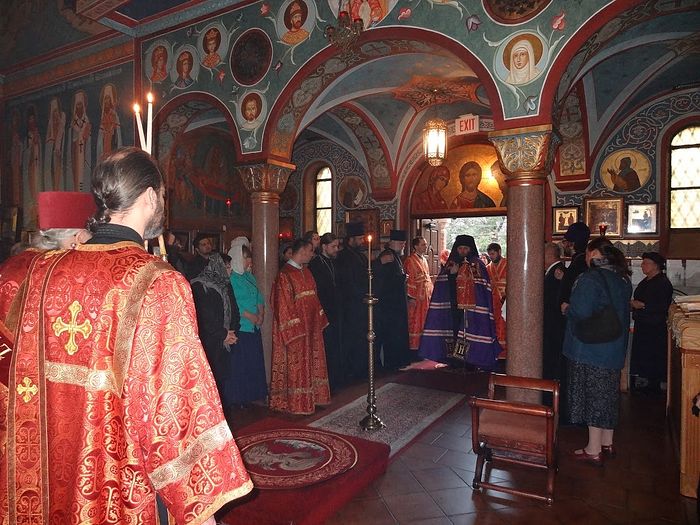 Meeting Bishop Nicholai of Manhattan.
Meeting Bishop Nicholai of Manhattan.
—Allow me to remind our readers of this icon’s history.
According to tradition, the icon was found on the day of the Nativity of the Most Holy Theotokos in a forest not far from Kursk, which had just been burned down by the Tatars in 1295. On that place where the icon revealed itself a spring welled up. The hunter who found the icon built a chapel for it, but the Tatars burned down that chapel, and hacked the icon in half. The miraculous icon grew back together in the hands of priest Bogoliub.
It remained in a monastery built on the site of the chapel—the Root Hermitage. From this came the name, Kursk-Root. The Most Holy Theotokos through her miraculous icon blessed many Russian people, comforting them in sickness and sorrows. In 1767 a seriously ill boy from Kursk was healed through the icon—this was the future luminary of the Russian land, St. Seraphim of Sarov.
In 1920 the miraculous icon left Russia during the retreat of the White Army from Crimea. The road to America was long—through Serbia and Bavaria. In 1966, St. John of Shanghai blessedly reposed during prayers before this icon in his cell.
Why did the icon leave Russia? Do not be concerned, my dear readers! The holy fathers usually say that holy shrines like this miraculous icon are not moved from their place without the special will of the Most Holy Mother of God.
The “White” exodus from Crimea was nearly 150 thousand Russian Orthodox people, and the Mother of God deigned to grant them her miraculous icon for a consolation in exile.
Bishop Nicholai said that no other icon traveled so long and far as the Kursk Root icon. Moreover it visited not only churches but also hospital wards and houses where there were seriously ill people. “And this can also be considered a great miracle: the Mother of God goes where she wants,” noted Bishop Nicholai.
March 21 is the commemoration date of when the icon was saved from malefactors who attempted to blow it up in the Kursk Cathedral of the Sign in 1898.
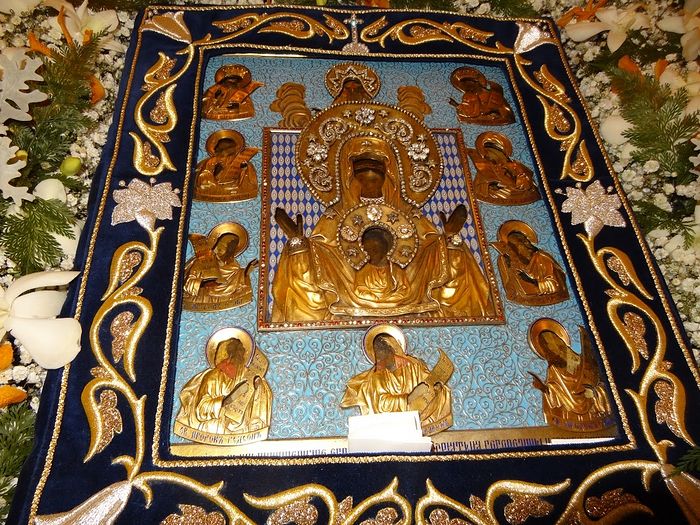 The Kursk-Root icon of the Most Holy Theotokos
The Kursk-Root icon of the Most Holy Theotokos
—Fr. Victor, do miraculous healings occur from the icon in our day?
—You know, when I served at my first parish in the town of Stratford, Connecticut, 1975 (I was ordained in 1974), the Kursk-Root icon came to us. After services in our church I took the icon to the neighboring city, to the Church of the Holy Spirit. There we served a moleben with an Akathist.
I noticed that one young man stood the whole time there, covered with tears and on his knees. He was praying very hard. After the service he came up to me and told me that his little son had some very rare disease—the skin on his neck hung in folds like on an elephant. It was horrible to see. He pressed his son to the miracle-working icon.
I said, “It’s good that you came. Have faith that the Most Holy Theotokos will intercede for your son!”
A few days later he returned to the church with his son—this time to request a moleben of thanksgiving. They went to yet another meeting with the doctor, who with great amazement discovered that the sick boy had begun to recover. Many years later I learned that this boy had grown up and gotten married.
Archpriest Vladimir Danilievich knew one Jewish family. Their seven-year-old boy had been diagnosed with cancer. It was just as the miracle-working icon was due to arrive. The family was already inclined towards becoming Christian, but none of them had yet been baptized. They brought the boy who venerated the icon—and was healed. They were so grateful; this made such an impression! The entire family was baptized right away and soon became very active parishioners.
My matushka’s elder sister, Alexandra, was very sick with polio as a child in Belgrad. She could not swallow or take food. The child was having a crisis in the disease’s development. They invited the Kursk-Root icon and prayed before it. The priest gave Alexandra Communion—it was the first time in several days when she could swallow the Communion—and after that she was able to take food and was finally healed.
—Do you still visit the sick in your parish with the icon?
—Yes, one of the days that that icon was with us was specially dedicated to visiting the sick and elderly parishioners who were deprived of the possibility of coming to the church. The icon visited nine people living in Washington, D.C., Maryland, and Virginia.
Especially memorable was the visit to the bedridden Stephan Petrovich Sudakov. I had given him Communion not long before this and felt that he was about to depart this life. I promised to bring the icon to him. He lived in Virginia, a long drive… I was in a hurry—a priest from the Romanian parish was waiting for me to bring the icon to the Vespers service in their church. We were driving too long, traffic jams everywhere, and I was going to be late. I was also very tired, barely on my feet. I even thought of giving up on my intention but matushka talked me out of it: “Let’s go,” she said, “Let’s try, what if he dies? After all, you promised him…” I called the priest and warned him that I would probably be late with the icon. He answered, “No problem, there is still time.”
We were in time to console Stephan Petrovich with this icon and give him Communion. He was still alive and conscious. A few hours later he gave his soul to God. He had a great love and veneration for this icon, and here at the last moment of his life his final emotion was joy from his beloved icon. The Most Holy Theotokos led this good man and parishioner of our church on his final journey to her Divine Son! For me this was such a consolation, as it was also for his wife… And I was only a half hour late for the Vespers service.
I was visiting one American with the miraculous icon last year. He is a well-known lawyer who suffers from cancer. When I arrived at his home he was dying. This year I expected to come to dying man. But he opened the door, fresh as a daisy. They believe that the Mother of God healed him. He is in complete remission and intends to return to his law practice.
Bishop Nicholai agreed once on the road home to New York to stop in Baltimore to visit the nine-year-old girl, Nadya, who suffers from brain cancer.
Every year the Kursk-Root icon also goes to Russia, travels to different dioceses, to Kursk, Ekaterinburg, and other cities… The icon is accompanied by its guardian, Bishop Nicholai.
—Thank you dear Fr. Victor for your wonderful talk!
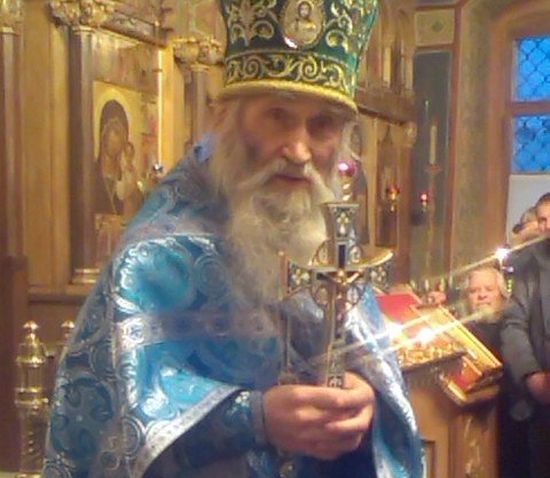 Schema-Archimandrite Ilie (Nozdrin)
Schema-Archimandrite Ilie (Nozdrin)
—You know, the Optina elder Ilie once came to visit us. Someone brought to us an old, nineteenth century icon of the “Unexpected Joy”. I made a little call after Vigil service: well, you see, someone is offering to sell us this icon. But Fr. Ilie called me over and said, “No need, no need! It’s yours!” And he bought it for our parish! He gave the money for it and now we have an icon that is, basically, from him. So, please give our regards to Optina Monastery.
May God preserve you!

